
- Places to Visit
- Sightseeing
- Practical Tips
- Where to Stay

London Congestion Charge
The London Congestion Charge is a fee to drive in parts of central London (the Congestion Charge Zone) between:
Monday–Friday: 7am–6pm (07:00–18:00) Saturday & Sunday and bank holidays : 12pm–6pm (12:00–18:00)
How much is the London Congestion Charge?
Important! The ULEZ is an additional charge for driving in London if you drive an older car, motorbike, van or moped. The ULEZ zone expanded to cover (nearly) the whole of London in August 2023
The Congestion Charge is £15 per vehicle per day if you pay in advance or before midnight on the day you enter the zone.
If you forget, you can still pay the fee up to three days later but the price increases to £17.50 .
You can drive in and out of the congestion zone as many times as you like on the day — you only pay one fee.
Do I pay if I park in a car park in the Congestion Zone?
The charge only applies when you actually drive your car in the congestion zone during the congestion charge period (7am–6pm Monday–Friday, 12pm–6pm Saturday & Sunday).
If you leave your car in a car park for a few days, you don’t have to pay the congestion charge on the days you don’t use your car. You only pay the charge for the day you drive to or from the car park IF it’s during the congestion charge period.
Congestion Charge Times
The Congestion Charge applies:
Monday–Friday: 7am–6pm (07:00–18:00) Saturday & Sunday: 12pm–6pm (12:00–18:00) Bank Holidays: 12pm–6pm (12:00–18:00)
There is no Congestion Charge :
- Monday to Thursday between 6pm–7am (18:00–07:00)
- Friday 6pm–12pm Saturday (18:00–12:00)
- Saturday 6pm–12pm Sunday (18:00–12:00)
- Sunday 6pm–7am Monday (18:00–07:00)
In 2025, there is no Congestion Charge on Friday 18 April (Good Friday) or Monday 21 April (Easter Monday).
There is usually no Congestion Charge on Christmas Day (25 December), Boxing Day (26 December), 27–31 December and New Year’s Day (1st January).
How to pay the Congestion Charge
There are several ways to pay. These are the quickest ways for visitors to pay:
You can pay the Congestion Charge online with TfL. You don’t need to register or create a password, but you do need to enter your vehicle registration number and the country of registration. Payment is made by credit or debit card.
Only use the official Transport for London (TfL) website to pay the Congestion Charge. This is the official website URL :
https://tfl.gov.uk/modes/driving/congestion-charge
Do not use other websites to pay. They charge more than the official rate – in some cases up to £5 extra. The maximum amount you should pay is £15 on the day, or £17.50 up to three days following the date of travel. Prices increased on 22 June 2020.
Pay via the TfL Pay to Drive in London app
TfL has a Pay to Drive in London app to pay the charge. It’s available from the Apple app store or Google Play . The app is free to download.
Pay by phone
Call TfL Pay to Drive in London Service on 0343 222 2222 from within the UK, or +44 343 222 2222 from outside the UK.
Open: Monday—Saturday 06:00—00:00. (6am—midnight)
You will need:
- the vehicle registration number
- country of registration
- your credit/debit card details.
If you enter the London Congestion Zone on a regular basis, there are easier ways to pay .
You can’t pay the Congestion Charge in shops and petrol stations. This was withdrawn in 2013.
What if I don’t pay?
Cameras record when you enter and exit the zone. If payment is not received by midnight on the third day after entering the CCZ, a Penalty Charge Notice (PCN) for £160 is sent to your home address. If you pay within 14 days, the fine is reduced to £80 .
Where is the Congestion Charge Zone (CCZ)?
The Congestion Charge Zone covers most of central London including the City of Westminster, the City of London and parts of the London Boroughs of Camden, Lambeth and Southwark.
See a map of the London Congestion Charge Zone
Please note that the speed limit in the Congestion Charge Zone is now 20 miles per hour (32 kmh).
Which postcodes are in the Congestion Charge zone?
- EC1, EC2, EC3, EC4
- SE1 (parts)
- SE11 (parts)
- SW1 (parts)
How to find out if an address is in the Congestion Charge Zone
If you know the street name or postcode, check if it’s in the Congestion Zone area .
Congestion zone signs
There are no toll booths at the start of the Congestion Zone. When you enter and exit the zone, cameras record your number plate.
There are signs on roads approaching central London telling you how far you are from the Congestion Charge Zone:
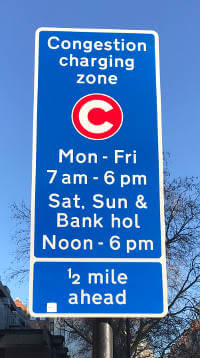
When you enter the Zone, you see the following sign:
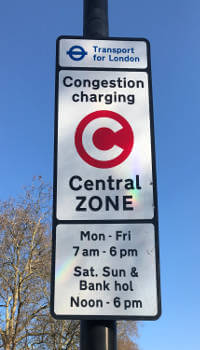
When you exit the Zone, you see the following sign (bottom sign):
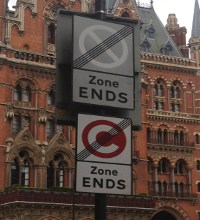
Within the zone itself, you will see large red circles, with a white ‘C’ marked on the roads.
How to avoid the Congestion Charge
Don’t bring your car into central London. Park outside central London and use the underground, National Rail or buses to travel to central London.
- ULEZ Charge
If you drive an older vehicle, there is a £12.50 Ultra Low Emission Zone Charge (ULEZ) charge for driving into London. (the ULEZ zone expanded to cover the whole of London in August 2023).
Please read our guide to the ULEZ , especially if you drive a car registered outside the UK
Related pages
- Congestion Zone map
- Parking in London
- London Transport tickets and passes
Practical tips
- Left luggage – Central London
- Left luggage – Heathrow airport
- Left luggage – Gatwick airport
- London weather forecast
- Central London laundrettes
- London congestion charge
- Congestion charge zone map
- Tourist Information Centres
- Central London libraries
Popular pages
- Guide to London's transport tickets
- Left luggage offices
- Congestion Charge
- London transport zones
- Bus tickets & passes
- 2 for 1 discounts at London attractions
- Oyster cards
- Top free museums & galleries
- Cheap eating tips
- Heathrow to London by underground
Copyright 2010-2024 toptiplondon.com. All rights reserved. Contact us | Disclaimer | Privacy
LATEST DEALS:
- Best 0% APR finance
- Best deposit contributions
- Cheapest cash offers
- Cheapest PCP offers
Back to top
London Congestion Charge: everything you need to know
From christmas 2025, drivers of all vehicles, including electric cars, will have to pay a £15 daily fee. we explain the london congestion charge and who has to pay it....

Nissan Ariya
The London Congestion Charge is a daily fee levied on vehicles travelling through the centre of the capital at certain times.
Presently, drivers of most vehicles must pay the £15 a day fee, although zero-emission electric vehicles are exempt
However, from the end of next year, this exemption will be removed, meaning all vehicles, including electric cars , will be liable for the £15 a day fee.
Commenting on the change, a spokesperson for Transport for London said: “The Congestion Charge’s Cleaner Vehicle Discount was part of our phased scheme to tackle London’s toxic air.
“Ending the Cleaner Vehicle Discount from 25 December 2025 will maintain the effectiveness of the Congestion Charge, which is in place to manage traffic and congestion in the heart of London.”
The termination of EV discounts could sting around 100,000 drivers living in and around the capital, it has been estimated. In 2022, there were around 69,000 pure electric vehicles and plug-in hybrids in the capital, and that figure is certain to have increased as people switch to greener cars to avoid emissions-based fees.
The scrapping of the EV exemption from the Congestion Charge is another blow for EV buyers who lost the Plug-in Car Grant incentive for buying new electric models in 2022 and, as of April 2025, will have to pay road tax (VED) just like those who run petrol and diesel cars.
What is the London Congestion Charge?
The London Congestion Charge is a daily fee levied on vehicles travelling through the centre of the capital. In June 2020, its cost was increased to £15 a day (up from £11.50) and the hours of operation changed from 7am to 6pm weekdays to 7am and 10pm every day except Christmas Day.
The costs and operating times were increased partly to combat increasing traffic and pollution levels in the city after the first coronavirus lockdown ended, and also to help Transport for London (TfL) recoup money it had lost in fares during the pandemic. The increase was reported to be temporary, but no end date for it has been announced yet.
The fee was originally introduced in 2003 to reduce traffic and emissions in inner-city areas. In the first three years of its operation, traffic dropped by 15% and congestion fell by 30%. When traffic volumes in the zone were measured in 2018, they were a quarter lower than they had been a decade earlier.

The Congestion Zone covers 1.3% of Greater London, stretching from the City in the east to Marylebone in the west, and from Lambeth in south London to Finsbury north of the River Thames. It covers an area of eight square miles in total.
London’s Ultra Low Emission Zone (ULEZ) used to cover the same area, but in August 2023 it expanded to cover almost all of the area inside the M25 motorway, encompassing around 600 square miles of territory, and all 32 London boroughs.
Who has to pay the London Congestion Charge?
The drivers of most cars have to pay the Congestion Charge. The only exemptions are for the following groups of people: residents who applied for a discount before 1 August 2020; drivers with disabilities who have a Blue Badge; local authority, charity and NHS workers and vulnerable patients. The residents’ discount is 90% and the other groups don’t have to pay the charge at all.

There’s currently also a 100% cleaner vehicle discount for drivers of pure electric vehicles. However, from 25 December 2025 this discount is being discontinued.
How do I pay the London Congestion Charge?
If you want to pay for a single journey into the Congestion zone you can do so online at the TfL website , via the TfL app or by calling 0343 222 2222. If you pay the day before your journey, the fee is £15, but it rises to £17.50 if you pay on the same day or by midnight up to three days afterwards. If you leave it any longer than that you’ll be liable for a Fixed Penalty Notice fine of £160, although that's reduced to £80 if it’s paid within 14 days.
If you’re travelling into the Congestion Zone regularly, you can set up an Auto Pay account so the money is taken from your account automatically. If you are in an exempt group or drive a car that qualifies for a discount, you need to register with TfL in advance via the website. There’s an annual fee of £10 for registering your vehicle with TfL and for setting up an Auto Pay account, but doing so gives you the benefit of a £1 discount on the daily fee.
For all the latest reviews, advice and new car deals, sign up to the What Car? newsletter here
Next: The best electric cars >>

Best electric cars 2024 – the EVs to buy and those to avoid
Sales of electric cars are booming, and no wonder: the best are quiet, cheap to run and smooth to drive. But which are the brightest sparks – and which are the loose connections?

Nissan Leaf long-term test
What's an electric car like when you live with it every day? We're running a Nissan Leaf for six months to find out

New BMW i5 vs Mercedes EQE
BMW’s fully electric i5 aims to raise the bar for executive cars. But first it has to see off the Mercedes EQE

Why Sebastien Buemi loves his Nissan LEAF

Nissan LEAF: 8 great reasons to go electric

Gallery: Four staggeringly versatile Nissan LEAF concepts

10 amazing facts about the Nissan LEAF

How Nissan makes going electric easy

Made in Britain: how Nissan’s electric cars are home-grown in the UK
Also consider, quick search.
- All car reviews
- All new car deals
- Used cars for sale
- All used makes
- Vans and commercial vehicles
- New car awards
- Used car awards
- Classic & Sports Car
- Move Electric
Tools & services
- Car finance
- Car warranty
- Gap insurance
- Sell your car
- Car Leasing
- Car Valuation
- Company car tax calculator
- Van tax calculator
- Terms & conditions
- Cookie policy
- Privacy policy
Information
- About What Car?
- Contact What Car?
- Subscribe to our newsletter
- Subscribe to What Car? magazine

What Car? is part of Haymarket Automotive , a division of Haymarket Media Group © Haymarket Media Group 2024

- DOLPHIN SQUARE
- DOLPHIN HOUSE

Avoiding the London Congestion Zone: How to Plan your London Travel [Updated for 2022]

The Congestion Zone can be confusing and expensive. It’s easy to drive through it, bleary-eyed one morning without even realising you’ve done so - until you’re hit with a fine.
We've written elsewhere about whether Dolphin Square is in the Congestion Zone and ULEZ , and this article demystifies what and where the London Congestion Zone is.
You'll find out how to pay it and - most importantly - how to avoid it, especially when you’re figuring out where to stay in London and how to travel around the city.
Where and What is the London Congestion Zone?
Where is the london congestion zone.
The Congestion Zone is an area in London, spanning roughly from Kings Cross to Vauxhall and Paddington to Whitechapel. This area was mapped out and selected in 2003 (when the policy came into action) as an area prone to the highest levels of traffic in London. Driving in this area now comes with at least one fee (the Congestion Charge or “CC”).
You can use this interactive Congestion Zone map to see if places you want to go are in the CC Zone.
You also need to be aware of the Ultra Low Emissions Zone ( ULEZ ) - an initiative to try and decrease air pollution in the capital that covers a much larger area . The Congestion Zone in its entirety sits within the ULEZ.
ULEZ applies all day every day (except Christmas day) and if your car doesn’t meet the outlined criteria then you may have to pay this in addition to the Congestion Charge.
The Congestion Charge is £12.50 a day for cars, smaller vans, motorbikes and other lighter vehicles - it’s considerably more for HGVs and coaches.
The Charge is payable by every vehicle that drives through the congestion zone which emits a greater rate than 76g/km CO2 (this includes most cars, vans and motorised bikes.)
The Congestion Charge aims to reduce traffic levels in central London, make journeys on foot or bike safer and less polluted and to support the bus network being more reliable. Money gathered from the charge is poured back into London public transport, making it smoother and safer to get around. And it seems to be working .
The Congestion Charge applies from 0700-1800 Monday to Friday and 1200-1800 on weekends and bank holidays. Between Christmas day and New Year's Day (25-31 December you wont need to pay).
The charge is enforced using Automated Number Plate Recognition (ANPR) technology, monitoring every vehicle which enters or exits the zone in real-time.
Coronavirus measures
Transport for London made temporary changes to the charges to discourage people from driving in London during the coronavirus pandemic. Here's the original announcement of these changes.
There were also new policies around reimbursement including:
- An expanded NHS patient reimbursement scheme for people vulnerable to coronavirus.
- A new reimbursement arrangement for local authorities and charities operating in the zone where they are providing certain support or services in response to the pandemic (including domiciliary care workers providing services on behalf of a local authority and volunteers supporting shielding residents).
Please note: these temporary changes have now been reversed .
Paying the Charge
There are a range of ways to pay - including automatically with Auto Pay, in advance, on the day or for 3 days following your journey. You can also pay for a custom date range using TFL’s “ Pay to Drive London ” tool.

Is Dolphin Square located in the Congestion Zone?
We've written in depth about this in another blog post , but the short answer is no : Pimlico - where Dolphin Square ’s wonderful serviced apartments are located - is right on the cusp of the Congestion Zone. Dolphin Square itself is just a few streets away from the boundary, on the outside! So you can reach your apartment by road without having to pay the fee.
One of the brilliant guest amenities available at Dolphin Square is onsite parking - so residents can leave their vehicle there and head into the Congestion Zone by other means of transport, saving money.
Our serviced apartments are less than a 5-minute walk from Pimlico Tube Station , providing incredible convenience and access to excellent transport links and the rest of the city.
There are all sorts of alternative ways to travel into and through the Congestion Zone and ways to plan your route , including the TFL website and with the CityMapper app .
Which postcodes are in the Congestion Zone?
The following postcodes are within the London Congestion Zone: EC1, EC2, EC3, EC4, SE1, SW1, W1, WC1 and WC2.
So if your destination is located in any of these, then you won’t be able to drive in privately without paying the Congestion Charge (unless you do it between Christmas and New Year or late in the evening) so you’ll either need to cough up or choose another way to get there. See below for more details about other options.
If you aren’t sure about a postcode you can use this site to see if it’s in the Congestion Zone. Check out this informative blog from more information on travelling in, paying and appealing the Congestion Charge.
Driving across London without having to pay
So you want to get to the other side of London... On Google Maps you can get directions which specifically avoid any tolls.
Open a location in Maps e.g. the Emirates Stadium in Highbury, then click the blue circle with the arrow in it for directions.
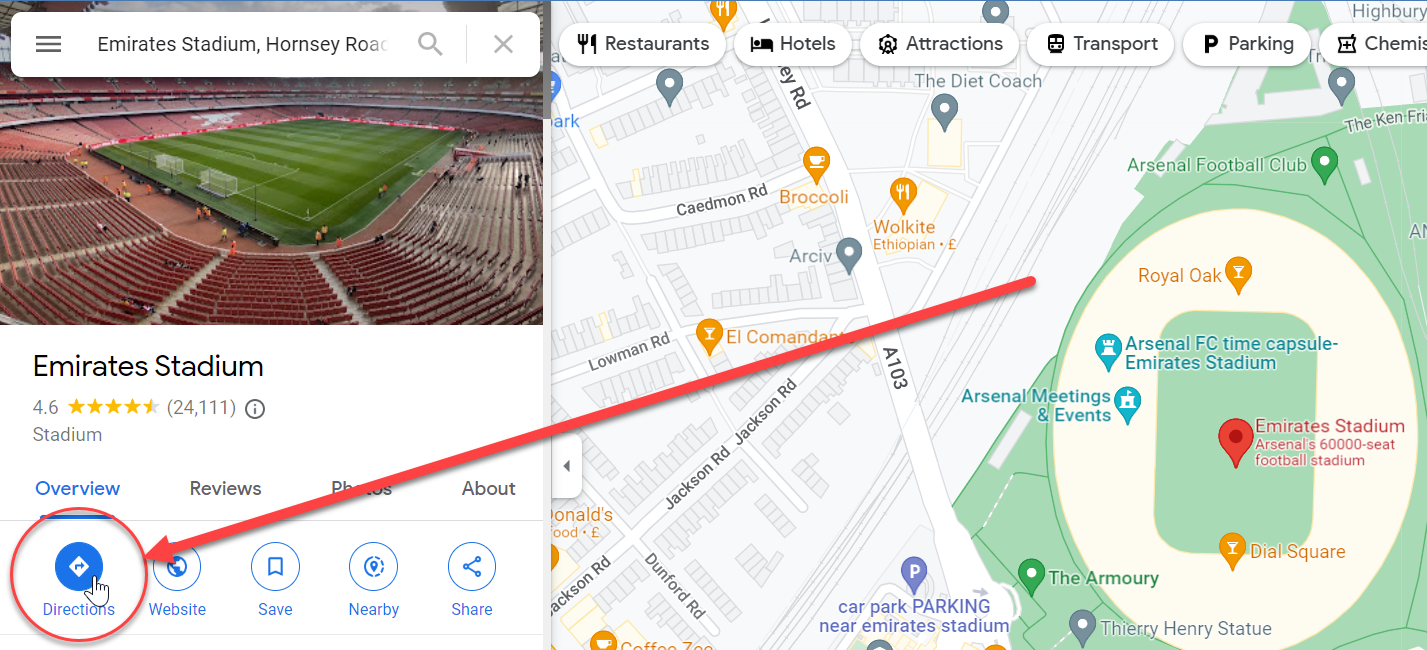
Enter your starting point, e.g. Dolphin Square Serviced Apartments.
By default you’ll be presented with the quickest route (marked 1 in the image below). You can select which mode of transport you’ll be using with the icons above your destination (2 below), choosing between driving, cycling, public transport, walking (or even flying).
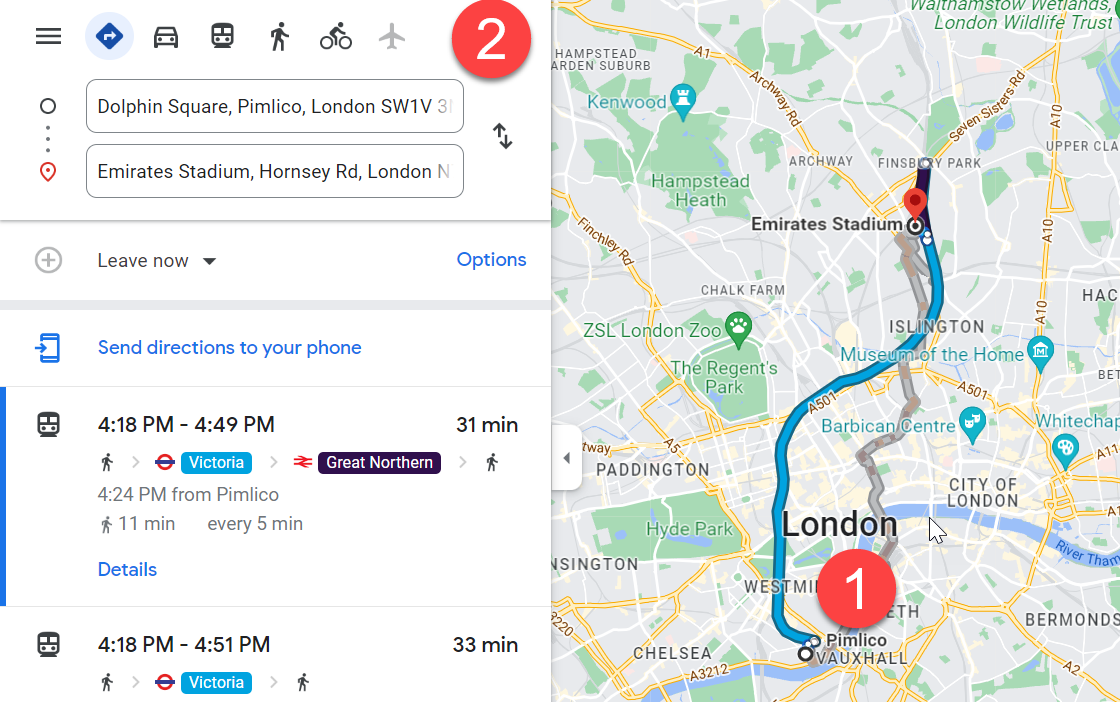
Using the above example, from Dolphin Square to Highbury, the quickest route by car between these points takes 29 minutes and directs you to drive straight through the city centre, but as you may have noticed this comes up with an amber warning “This route has tolls”. That’s the Congestion Charge.
You can bypass this though! Below the ‘Destinations’ section on Google Maps, you should find an ‘Options’ hyperlink. Click on that and one of the options which comes up is ‘Avoid’. Tick the box next to ‘Tolls’ and your route should refresh, giving you a route which circumnavigates the Congestion Zone. In this example, the route becomes 8 minutes and almost 2 miles longer, but you won’t get dinged with a £12.50 fee.
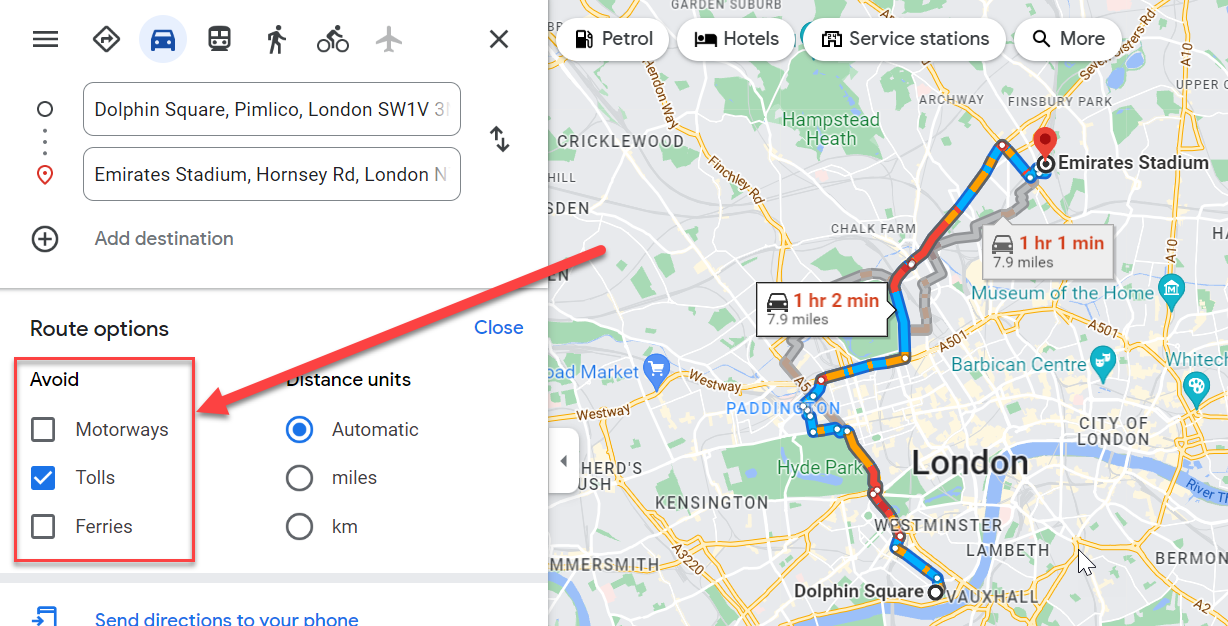
No Congestion Charge - alternatives
One of the best things about London is the brilliant public transport service. With 8,600 buses, 270 Tube stations and 12 major train stations connecting the city with the rest of the country - as well as Santander Cycles , great cycle lanes, black cabs, UBER and even water buses and taxis - there’s no shortage of alternative ways to get around!
Google Maps has a feature where you can select “Recommended Travel Mode” and tweak it to your needs (e.g. wheelchair accessible, fewest changes etc.)
Bringing down the cost of private travel
Sometimes driving is the most convenient way - it’s not always practical to bring a huge portfolio and all your props for a presentation with you on a Boris Bike. You could get a taxi - where the fee is either exempt or covered in the fare.
Carpool - you could (in line with COVID restrictions) share a ride with colleagues or friends, splitting the Congestion Charge between you.
This might not always be convenient - but if you’re flexible on timings then you could choose to travel outside of Congestion Charge hours - which run from 0700-1800 or 0700-1200 at weekends.
Using alternative modes of transport
The whole point of the Congestion Charge is to reduce traffic and pollution in the city centre, so you can do your part by taking advantage of all the brilliant alternatives available.
The Tube network is the original Underground Rail service in the world. It’s steeped in history and offers great, convenient service all over the capital.
Overground rail and the DLR (Docklands Light Railway) also make getting about a breeze. There are also thousands of buses and routes all over London - so you can always find a bus to hop on to, wherever you’re going.
Transport for London (TFL) has a new app which helps people plan routes around the city and maintain social distancing as well as take things like the Congestion Charge into account.
You could also if you’re able to and have the time - enjoy the sights and walk!
Breath Easy
So, now you know about the Congestion Charge and how to pay it, avoid it or get around it. Making the most of London’s public transport services and enjoying travelling in different ways couldn’t be simpler, as well as saving money on the Charge.
Those staying in Dolphin Square serviced apartments are in the best position to get close to central London in the luxury of their vehicle, but without having to fork out to drive through the centre, with convenient access to great public transport. So why not treat yourself and book a viewing today.
10 unmissable days out near London for adults
Days out for couples in london, do you like to be beside the seaside here are the best seaside days out near london.
- Studio Apartments
- One Bedroom Apartment
- Two Bedroom Apartment
- Three Bedroom Apartment
- Pimlico Life
- About Dolphin Square
- Serviced Apartments
- Guest Amenties
- Bar & Grill
- Welcome to DSQ Gym
- Memberships
- Book a Tour
- About the Spa
- Gift Vouchers
- About Short Lets
- Terms of Use
- CCTV Policy

Dolphin Square Operator Limited, Chichester Street, London SW1V 3LX. Find us on Google Maps
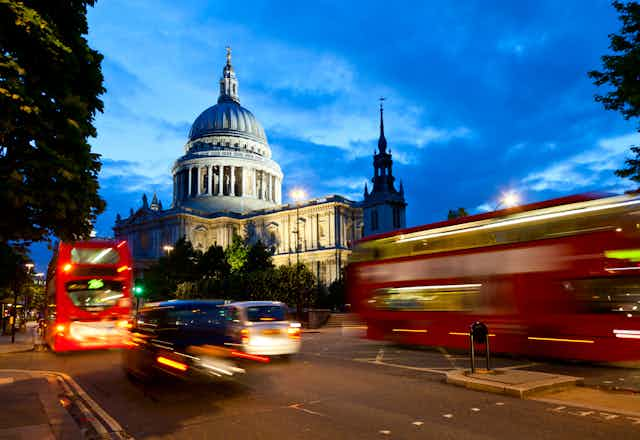
London congestion charge: what worked, what didn’t, what next
Researcher in Urban Infrastructure Policy and Governance, University of Cambridge
Disclosure statement
Nicole Badstuber received funding for her doctoral research into urban transport governance from the Engineering and Physical Sciences Research Council via the research programme Transforming the Engineering of Cities. Nicole currently works at the UCL Transport Institute as Knowledge Exchange Coordinator. Previous research projects Nicole has worked have separately been funded by MacArthur foundation, the New Climate Economy, the European Innovation Council via Horizon 2020 and UCL. Nicole is a ordinary student member of the Labour party. This article does not reflect the views of any research organisation Nicole has been or is associated with.
University of Cambridge provides funding as a member of The Conversation UK.
View all partners
When London’s congestion charge was introduced by the city’s first mayor, Ken Livingstone, he hoped the charge would reduce congestion, radically improve bus services, make journey times more consistent for drivers and increase efficiency for those distributing goods and services throughout the city.
Key measures show it has been a success: in 2006, Transport for London (TfL) reported that the charge reduced traffic by 15% and congestion – that is, the extra time a trip would take because of traffic – by 30%. This effect has continued to today. Traffic volumes in the charging zone are now nearly a quarter lower than a decade ago , allowing central London road space to be given over to cyclists and pedestrians.
The charge covers a 21km² area in London. It’s a simple system: if you enter the zone between 7am and 6pm on a weekday, you pay a flat daily rate. The charge has risen gradually from £5 in 2003 to £11.50 today. Residents receive a 90% discount and registered disabled people can travel for free. Emergency services, motorcycles, taxis and minicabs are exempt.
Recipe for success
Today, city leaders in places such as New York are facing resistance, as they consider introducing their own congestion charge in the urban core. But the same thing happened in London, 15 years ago: notable push-back came from Westminster Council , which took the issue to court, claiming it would cut residents off from education and healthcare services, but lost. If it weren’t for the 1999 law which centralised certain powers to the mayor, the charge may not have been realised at all.
London’s congestion charge succeeded for two key reasons: it had a clear and convincing premise, and it was just one part of larger efforts to improve travel across all forms of transport in the city. The case for congestion charging was simple: the charge would reduce traffic in the city centre and generate funds to reinvest in improving public transport services.
On the day the congestion charge was introduced in London, 300 extra buses were added to the Central London bus network to give people an alternative to driving and avert the anticipated mayhem. One year later, Livingstone reported that 29,000 more passengers had entered the charging zone by bus during the morning rush hour, compared to a year before. Between 2002 and 2014 , the number of private cars coming into the zone fell by 39%.
Getting busy
But while car numbers are down, the number of private for hire vehicles – your minicabs and Ubers – is up. Trips by taxi and private for hire vehicle as the main mode of the journey increased by 9.8% between 2015 and 2016 alone – and 29.2% since 2000. Today, more than 18,000 different private hire vehicles enter the congestion charging zone each day, with peaks on Friday and Saturday nights.
This has reduced the speed of traffic through the city centre, which in turn has affected the bus network. City Hall investigated and concluded that traffic congestion was the primary reason why bus usage was down in London: the slower the speed along bus routes, the greater the fall in passenger numbers.

Taxis and minicabs are exempt from paying the congestion charge, presenting a further, financial challenge for TfL. While minicab registrations have soared from 49,854 in 2013 to 87,409 in 2017, the income from the congestion charge has flat-lined. Last year, TfL registered its first drop in congestion charge income since 2010.
Stockholm solution
Now, authorities are looking abroad for solutions. Inspired by cities such as Stockholm, the London Assembly (the city’s government scrutiny body) has recommended extending the congestion charging zone and replacing the daily flat rate with a charging structure which would reflect when and where drivers enter the zone and how much time they spend there. In Stockholm, the zone covers 35km², capturing two-thirds of the city’s residents in a scheme with varying charge levels depending on the time of the day – the maximum daily charge does not exceed 105 Swedish Krona (about £9.20).
The London Assembly also recommended devolving the national vehicle exercise duty (an annual charge for private vehicle ownership, based how polluting the vehicle is) to the Mayor of London’s office. This would give city leaders another means to encourage sustainable travel.
In his 2018 Transport Strategy , Sadiq Khan – London’s current mayor – aims to have four out of every five trips through the city made by public transport, cycling or walking by 2040 – up from two-thirds today. The congestion charge will be kept under review, but the strategy hints that it could be merged with the city’s Low Emission and Ultra Low Emission Zones (the latter is set to start in 2019), which offer cheaper rates for low-emission vehicles, to help tackle air pollution.
Khan and TfL have a huge budget hole to fill , having lost their £700m a year operational grant from national government. Khan’s manifesto pledge to freeze fares will cost £640m over his term, and at the same time passenger numbers and fare revenues are down £240m . A reformed congestion charge could not only ease traffic – it could provide a much-needed new revenue stream for TfL. The mayor also seems to be investigating ending the exemption for minicabs.
After 15 years of operation, London’s congestion charge can be celebrated as a success. It has set the bar for other cities – demonstrating that road pricing can only be successful as part of strategy that offers efficient, sustainable alternatives for car drivers. Looking ahead, the congestion charge needs reform to meet the financial and logistical challenge of providing a good transport system for Londoners.
- Congestion charges
- Urban transport
- Road transport

Quantitative Analyst

Director of STEM

Community member - Training Delivery and Development Committee (Volunteer part-time)

Chief Executive Officer

Head of Evidence to Action
- Part exchange
- Archived cars
- Archived listings
- Report a purchase
- Communication preferences
- Browse in-stock new & used cars
- Browse leasing deals
- Sell your car
- New car reviews
- Car reviews
- Audi electric cars
- Audi hybrid cars
- BMW electric cars
- BMW hybrid cars
- Citroen electric cars
- Citroen hybrid cars
- Citroen SUVs
- Fiat electric cars
- Ford hybrid cars
- Genesis electric cars
- Honda hybrid cars
- Hyundai electric cars
- Hyundai hybrid cars
- Hyundai SUVs
- Jaguar hybrid cars
- Jaguar SUVs
- Kia electric cars
- Kia hybrid cars
- Lamborghini
- Land Rover hybrid cars
- Lexus electric cars
- Lexus hybrid cars
- Maserati SUVs
- Mazda hybrid cars
- Mercedes-Benz
- Mercedes-Benz electric cars
- Mercedes-Benz hybrid cars
- Mercedes-Benz SUVs
- MG electric cars
- MINI electric cars
- Nissan electric cars
- Peugeot electric cars
- Peugeot hybrid cars
- Peugeot SUVs
- Porsche electric cars
- Porsche SUVs
- Renault electric cars
- Renault hybrid cars
- Renault SUVs
- Rolls-Royce
- Skoda electric cars
- Smart electric cars
- Suzuki hybrid cars
- Suzuki SUVs
- Toyota hybrid cars
- Toyota SUVs
- Vauxhall electric cars
- Vauxhall hybrid cars
- Vauxhall SUVs
- Volkswagen electric cars
- Volkswagen hybrid cars
- Volkswagen SUVs
- Volvo electric cars
Not sure what you want? Find your perfect car with our Car chooser
- 7-Seater Cars
- Automatic Cars
- Convertible Cars
- Crossover Cars
- Electric Cars
- Estate Cars
- Executive Cars
- Family Cars
- Hot Hatches
- Hybrid Cars
- Luxury Cars
- Medium-sized Cars
- Most Economical Cars
- Motability Cars
- Saloon Cars
- Sports Cars
- Audi A1 Sportback
- BMW 1 Series
- Cupra Formentor
- Ford Fiesta
- Honda Civic
- Hyundai Ioniq 5
- Hyundai Tucson
- Hyundai i10
- Kia Sportage
- Land Rover Defender
- Mercedes-Benz A-Class
- Nissan Juke
- Nissan Qashqai
- Peugeot 2008
- Peugeot 208
- Peugeot 3008
- Range Rover
- Range Rover Evoque
- Skoda Karoq
- Skoda Kodiaq
- Tesla Model 3
- Tesla Model Y
- Toyota Aygo X
- Toyota Yaris Hybrid
- Vauxhall Corsa
- Vauxhall Mokka
- Volkswagen Golf
- Volkswagen Polo
- Volkswagen Tiguan
- Nearly new cars
- Car chooser
- Compare cars side-by-side
- New car delivery times
- Fuel chooser
- PCP calculator
- How we test cars
- Used Abarth cars
- Used Alfa Romeo cars
- Used Alpine cars
- Used Audi cars
- Used Bentley cars
- Used BMW cars
- Used BYD cars
- Used Citroen cars
- Used Cupra cars
- Used Dacia cars
- Used DS cars
- Used Ferrari cars
- Used Fiat cars
- Used Ford cars
- Used Genesis cars
- Used GWM Ora cars
- Used Honda cars
- Used Hyundai cars
- Used Infiniti cars
- Used Jaguar cars
- Used Jeep cars
- Used KGM Motors cars
- Used Kia cars
- Used Lamborghini cars
- Used Land Rover cars
- Used Lexus cars
- Used Lotus cars
- Used Mazda cars
- Used Mercedes-Benz cars
- Used MG cars
- Used MINI cars
- Used Mitsubishi cars
- Used Nissan cars
- Used Peugeot cars
- Used Polestar cars
- Used Porsche cars
- Used Renault cars
- Used Rolls-Royce cars
- Used SEAT cars
- Used Skoda cars
- Used Smart cars
- Used SsangYong cars
- Used Subaru cars
- Used Suzuki cars
- Used Tesla cars
- Used Toyota cars
- Used Vauxhall cars
- Used Volkswagen cars
- Used Volvo cars
- Used Kia Picanto
- Used Peugeot 108
- Used Volkswagen Polo
- Used Ford Fiesta
- Used Renault Clio
- Used MINI 3-Door Hatch
- Used SEAT Arona
- Used Ford Fiesta Active
- Used MINI Paceman
- Used Vauxhall Mokka
- Used Fiat 124 Spider
- Used Honda Jazz
- Used Skoda Karoq
- Used Toyota Yaris Hybrid
- Used Toyota Corolla
- Used BMW 2 Series (2014-2021)
- Used Volkswagen Golf
- Used Nissan Qashqai
- Used Range Rover Evoque
- Used Mercedes-Benz A-Class
- Used Mercedes-Benz GLA
- Used Lexus UX
- Used Mercedes-Benz C-Class Saloon
- Used BMW X1
- Used Toyota RAV4 Hybrid
- Used Volkswagen Tiguan
- Used Audi A4 Avant
- Used Discovery Sport
- Used Audi Q5
- Used Jaguar F-PACE
- Used Volvo XC90
- Used Mercedes-Benz GLC
- Used cars in Aberdeen
- Used cars in Birmingham
- Used cars in Bristol
- Used cars in Cardiff
- Used cars in Doncaster
- Used cars in Dundee
- Used cars in Edinburgh
- Used cars in Glasgow
- Used cars in Leeds
- Used cars in Leicester
- Used cars in Lincoln
- Used cars in Liverpool
- Used cars in London
- Used cars in Manchester
- Used cars in Milton Keynes
- Used cars in Newport
- Used cars in Northampton
- Used cars in Norwich
- Used cars in Nottingham
- Used cars in Plymouth
- Used cars in Sheffield
- Used cars in Southampton
- Used cars in Stoke-on-Trent
- Used cars in Swansea
- Car history checker
- Car leasing
- Business car leasing
- Abarth lease deals
- Alfa Romeo lease deals
- Alpine lease deals
- Audi lease deals
- BMW lease deals
- BYD lease deals
- Citroen lease deals
- Cupra lease deals
- Dacia lease deals
- DS lease deals
- Fiat lease deals
- Ford lease deals
- Genesis lease deals
- GWM Ora lease deals
- Honda lease deals
- Hyundai lease deals
- Jaguar lease deals
- Jeep lease deals
- KGM Motors lease deals
- Kia lease deals
- Land Rover lease deals
- Lexus lease deals
- Maserati lease deals
- Mazda lease deals
- Mercedes-Benz lease deals
- MG lease deals
- MINI lease deals
- Nissan lease deals
- Peugeot lease deals
- Polestar lease deals
- Porsche lease deals
- Renault lease deals
- SEAT lease deals
- Skoda lease deals
- Smart lease deals
- Subaru lease deals
- Suzuki lease deals
- Tesla lease deals
- Toyota lease deals
- Vauxhall lease deals
- Volkswagen lease deals
- Volvo lease deals
- 7-seater car lease deals
- Convertible car lease deals
- Electric car lease deals
- Estate car lease deals
- Hybrid car lease deals
- Small car lease deals
- Sports car lease deals
- SUV lease deals
- Vauxhall Corsa lease deals
- Volkswagen Polo lease deals
- Ford Fiesta lease deals
- Nissan Juke lease deals
- Audi A1 Sportback lease deals
- Skoda Kamiq lease deals
- Peugeot 2008 lease deals
- Ford Puma lease deals
- Nissan Qashqai lease deals
- Volkswagen Golf lease deals
- Ford Focus lease deals
- Audi A3 Sportback lease deals
- Volkswagen T-Roc lease deals
- Kia Sportage lease deals
- BMW 1 Series lease deals
- Toyota C-HR lease deals
- Hyundai Tucson lease deals
- Ford Kuga lease deals
- BMW 2 Series Gran Coupe lease deals
- Volkswagen Tiguan lease deals
- Volkswagen ID3 lease deals
- Volvo XC40 lease deals
- Volkswagen Golf GTI lease deals
- Tesla Model 3 lease deals
- Range Rover Evoque lease deals
- BMW 3 Series lease deals
- Volkswagen Golf R lease deals
- Jaguar F-PACE lease deals
- Range Rover Velar lease deals
- Discovery lease deals
- Audi Q7 lease deals
- Range Rover Sport lease deals
- New car deals
- Abarth Deals
- Alfa Romeo Deals
- Alpine Deals
- Citroen Deals
- Cupra Deals
- Dacia Deals
- Genesis Deals
- GWM Ora Deals
- Honda Deals
- Hyundai Deals
- INEOS Deals
- Jaguar Deals
- KGM Motors Deals
- Land Rover Deals
- Lexus Deals
- Lotus Deals
- Mazda Deals
- Mercedes-Benz Deals
- Nissan Deals
- OMODA Deals
- Peugeot Deals
- Polestar Deals
- Renault Deals
- Skoda Deals
- Smart Deals
- Subaru Deals
- Suzuki Deals
- Tesla Deals
- Toyota Deals
- Vauxhall Deals
- Volkswagen Deals
- Volvo Deals
- Dacia Sandero Deals
- Dacia Duster Deals
- Vauxhall Corsa Deals
- Volkswagen Polo Deals
- Ford Puma Deals
- Peugeot 2008 Deals
- Volkswagen Golf Deals
- Nissan Leaf Deals
- Kia Sportage Deals
- Vauxhall Mokka Electric Deals
- MINI Cooper Electric Deals
- Nissan Qashqai Deals
- Mercedes-Benz A-Class Deals
- Hyundai Tucson Deals
- Ford Kuga Deals
- Volkswagen Tiguan Deals
- Peugeot 3008 Deals
- Cupra Formentor Deals
- Volvo XC40 Deals
- Skoda Kodiaq Deals
- Hyundai Ioniq 5 Deals
- Tesla Model 3 Deals
- Range Rover Evoque Deals
- Kia Sorento Deals
- Volkswagen ID4 Deals
- Jaguar F-PACE Deals
- Volvo XC60 Deals
- Volvo XC90 Deals
- BMW M2 Deals
- 0% car finance deals
- No deposit car finance deals
- Cars with cheap insurance deals
- Immediate delivery deals
- Quick delivery EV deals
- Sell my car
- Sell my car Aberdeen
- Sell my car Birmingham
- Sell my car Bradford
- Sell my car Bristol
- Sell my car Cardiff
- Sell my car Derby
- Sell my car Doncaster
- Sell my car Edinburgh
- Sell my car Glasgow
- Sell my car in Coventry
- Sell my car in Newcastle
- Sell my car Leeds
- Sell my car Leicester
- Sell my car Lincoln
- Sell my car Liverpool
- Sell my car London
- Sell my car Manchester
- Sell my car Milton Keynes
- Sell my car Northampton
- Sell my car Norwich
- Sell my car Nottingham
- Sell my car Peterborough
- Sell my car Plymouth
- Sell my car Reading
- Sell my car Sheffield
- Sell my car Southampton
- Sell my car Swansea
- Sell my car Swindon
- Sell my Aston Martin
- Sell my Audi
- Sell my BMW
- Sell my Citroen
- Sell my Ferrari
- Sell my Ford
- Sell my Jaguar
- Sell my Land Rover
- Sell my Mercedes
- Sell my MINI
- Sell my Nissan
- Sell my Porsche
- Sell my Tesla
- Sell my Toyota
- Sell my Vauxhall
- Sell my Volkswagen
- Part exchange my car
- Value my car
- Sell my van
Electric cars
- Best electric cars
- Cheap electric cars
- Most efficient electric cars
- Longest range electric cars
- Electric family cars
- Electric SUVs
- Fastest electric cars
- Small electric cars
- Used electric cars
- Audi Q4 e-tron
- Ford Mustang Mach-E
- Hyundai Kona Electric
- Nissan Ariya
- Nissan Leaf
- Peugeot e-2008
- Peugeot e-208
- Renault Megane E-Tech Electric
- Renault Scenic E-Tech
- Skoda Enyaq
- Carwow electric
- Compare electric car costs
- EV charging stations map
- Electric car statistics
- Tesla charging stations map
- Automotive news
- carwow newsroom
- Going electric
- Choosing a car
- Buying a car
- Financing a car
- Owning & running a car
- Selling a car
- Grants & discounts
- Driving rules and laws
- Automotive glossary
- YouTube and videos
- Miscellaneous automotive topics
- Congestion charge checker
- Fuel price checker
- MOT history checker
- ULEZ checker
- Vehicle Tax checker
- Clean air zone checker
- Aberdeen clean air zone checker
- Bath clean air zone checker
- Birmingham clean air zone checker
- Bristol clean air zone checker
- Dundee clean air zone checker
- Edinburgh clean air zone checker
- Glasgow clean air zone checker
- Newcastle clean air zone checker
- Portsmouth clean air zone checker
- Sheffield clean air zone checker
CONGESTION CHARGE CHECKER
How does the congestion charge checker work.
Using the congestion charge checker is as easy as entering your number plate. This will tell you whether or not you need to pay the charge. You can also enter a London postcode or address to see if it falls within the Congestion Charge Zone (CCZ).
Our tool also shows you the boundaries of the Ultra Low Emission Zone (ULEZ) and whether your vehicle is compliant. If not, you will need to pay additional charges.
What is the London congestion charge zone?
The London congestion charge was introduced in 2003 with the aim of reducing pollution and traffic in the capital. There’s a daily fee of £15 to drive into the centre of London, and this is separate from the ULEZ charge.
You can find out more about ULEZ and check if your car is ULEZ compliant .
Do I need to pay the congestion charge?
If you drive your petrol or diesel car into the CCZ, you’ll need to pay the fee. This is enforced using number plate recognition cameras which will record you entering the zone, and failure to pay the charge will result in a hefty fine.
Electric and hydrogen fuel cell vehicles are exempt from the congestion charge. If you want to sell your car and replace it with an electric car, you can use carwow. Selling your car is quick and hassle free, and you’ll get a great price from our trusted dealers.
Once you’ve got a great price for your old car, you can then check out the best deals on a electric cars . Our trusted dealers will offer you their best prices, meaning no haggling on the forecourts, and the car can even be delivered to your door.
Congestion zone FAQs
Where is the congestion charge zone.
The London Congestion charge operates inside the London inner ring road, including the City of London and the West End.
How much is the congestion charge?
The congestion charge is a flat fee of £15 per day for petrol, diesel and hybrid cars.
How do I pay the congestion charge?
The easiest way to pay the congestion charge is online using the TfL website . You can set up an Auto Pay account to automatically bill you for driving into London, so you don’t run the risk of forgetting to pay. You can also pay by phone.
What are the congestion charge times?
The congestion charge operates from 7am to 6pm Monday to Friday, and midday to 6pm on Saturdays, Sunday and public holidays.
Who is exempt from the congestion charge?
Zero-emission vehicles such as electric cars are exempt from paying the congestion charge, as are motorbikes. If you drive an EV, you need to apply for the Cleaner Vehicle Discount before driving into the charge zone. If you don’t, you still need to pay. Blue badge holders can also apply for a 100% discount, and residents can apply for a 90% discount.
How do I know if I’ve entered the congestion charge zone?
The congestion charge zone is signposted as you enter with a white ‘C’ in a red circle. This will be displayed on signposts and on road markings.
If you’re considering an electric car, our team of experts have rounded-up the best models on the market. Read on to hear what they had to say.
How much does it cost to charge an electric car?
To give you more complete details on the costs of electric motoring, carwow has gathered up some essential information.
How long does it take to charge an electric car?
To help with adjusting from petrol stations to charging stations, carwow has provided some essential information about electric motoring.
- Your questions answered
London Congestion Charge exempt cars: do electric cars pay to enter the CCZ?
Do electric cars have to pay the london congestion charge we explain the ins and outs of this daily levy for entering london's congestion charge zone (ccz).

In February 2003, the London Congestion Charging Scheme was introduced in order to address traffic and local air pollution in the Capital. Initially the Congestion Charge area only covered 22 square kilometres but in February 2007 the area doubled in size to the current 'Congestion Charge Zone', or CCZ for short.
This is not to be confused with the ULEZ (Ultra Low Emission Zone) introduced in 2019, which has since expanded and is set to expand again in 2023.
- London ULEZ: what is the London Ultra Low Emission Zone?
When you come to London it will be clear when you are entering the CCZ, you will spot a sign showing a white 'C' on a red circle and the words 'Congestion Charge'. The zone currently covers an area bordered roughly by the A501 inner ring road to the north, Hyde Park and Victoria to the west, Vauxhall Bridge at its southern tip, and Tower Bridge to the east. While the ULEZ is set to grow, there are currently no public plans to expand the Congestion Charge zone.
2020’s Covid pandemic lockdown saw the zone temporarily suspended, but the charge was brought back at a higher rate of £15 a day and with expanded operating hours from June 2020. Since February 2022, the Congestion Charge has applied from 7am to 6pm on weekdays and from midday to 6pm on Saturdays, Sundays and Bank Holidays but there is no charge between Christmas Day and New Year's Day bank holiday.
While low-emission vehicles previously escaped the Congestion Charge, these days only fully zero-emissions cars are exempt. But that won't be the case forever, as current plans see that exemption expire in December 2025. Note that exempt cars do not automatically escape the charge – they have to be registered as such beforehand with Transport for London (TfL).
What cars are exempt from the London Congestion Charge?
Until the 25th of December 2025, all purely electric cars, vans and other vehicles are Congestion Charge-exempt, because they have zero tailpipe emissions. This means if you drive a fully electric vehicle and register it with Transport for London (TfL) you won’t have to pay the Congestion Charge. Hybrid vehicles – even plug-in hybrids capable of running on pure-electric power for some distance – are not exempt. After December 2025, these drivers will incur the same £15 daily charge as all other drivers.
There are discounts available to residents living within the Congestion Charge Zone who can apply for up to a 90% Residents’ Discount from Transport for London, meaning they'll pay £1.50 every day they drive in the zone. You need to supply documents to prove your residency as well as the fact that you're the owner, registered keeper or authorised user of the vehicle in question. The discount costs residents £10 a year.
Blue Badge holders don't have to pay the Congestion Charge at all. However, as with all the other exemptions, it’s vital that the vehicles used by a Blue Badge holder – a maximum of two per badge – are first registered with TfL in order to qualify for exemption. The Blue Badge discount too still costs £10 and must be renewed in line with the Blue Badge expiry date, though if you renew within 90 days of the expiry date, no further charge is due.
Other vehicles facing no charge are those with nine or more seats, breakdown and recovery vehicles, and two-wheeled motorcycles or mopeds.
How does the London Congestion Charge work?
You only have to pay the charge once a day. That means you can drive in and out of the Congestion Charge Zone (CCZ) many times on the same day without facing further penalties. You pay the charge online, on Transport for London's website.
You can also pay the charge in advance, or wait until the next day to pay. However, doing the latter adds £3.50 to the total, bringing it to £18.50. Fail to pay by midnight the following day, and you’ll be served with a Penalty Charge Notice (PCN).
This fee has gone up recently to £180, though if you pay within 14 days, this is discounted to £90 – still a hefty sum, so if you think you’ll be entering the CCZ, it’s wise to pay as soon as possible. It is possible to appeal a PCN under certain conditions; for example, if you’ve already paid the charge, or your car is exempt and the PCN was served in error. A full list of conditions can be found on the TfL website.
How do you pay for the London Congestion Charge?
Paying to enter the Congestion Charge Zone (CCZ) is simple and can be done in advance of your travel date. Just visit the Transport for London (TFL) website, head to the ‘Pay to drive in London ’ section, click 'Pay', and follow the prompts to input your vehicle details and desired travel date. It's a simple process. Plus, you can conveniently settle the fee for the Ultra Low Emission Zone simultaneously.
What about the Ultra Low Emission Zones?
The London Ultra Low Emission Zone (ULEZ) was introduced in April 2019, operating 24 hours a day, seven days a week (except no charge between Christmas Day and New Year's Day bank holiday) in the same boundaries as the Congestion Charge Zone at the time. It’s completely separate to the Congestion Charge and drivers who enter the ULEZ zone and the Congestion Charge in a non-compliant vehicle have to pay both charges.
Petrol cars and vans that don't meet at least the Euro 4 emissions standard (and motorcycles that don’t meet Euro 3) have to pay £12.50 to enter the ULEZ area, while diesel cars and vans that don't meet at least the Euro 6 standard are liable for the charge.
This means that while Euro 4 and 5 petrol cars get away with not paying the ULEZ charge, Euro 5 diesels and earlier have to pay it. As a rough guide, diesel cars and vans registered before September 2016 aren't Euro 6 compliant. If in doubt, use TfL's online vehicle checker to see if you need to pay.
The ULEZ expanded on 25 October 2021 to encompass the entire 'inner London area' (i.e. the zone bounded by the North and South Circular Roads), and was expanded again on 29 August 2023. The new zone is considerably larger than before, covering all London Boroughs, extending out as far as the M25 in some places.
Given the number of London residents this will affect, the Mayor of London, Sadiq Khan, has set aside £110 million towards a scrappage scheme, in an effort to either get people into a cleaner vehicle, or help them retrofit an older one. Sadiq Khan has also stated that all Londoners who own non-compliant cars will be eligible for up to £2,000 to replace them on this scheme.
As with the CCZ, there is a £180 penalty charge if you haven’t paid the ULEZ fee by midnight of the day after your visit, with the same early payment discount of £90. There is a grace period until 24 October 2027 for vehicles registered to disabled and wheelchair access owners, as well as a handful of other concessions for certain vehicles; it’s worth checking the TfL website if you think your vehicle might be eligible.
It’s worth noting too that historic vehicles of more than 40 years old are also eligible for exemption, alongside their exemption from MOT testing and zero-rate VED .
What are other UK cities doing?
Birmingham, Bath, Bristol, Glasgow and Bradford are just five examples of UK cities that have successfully introduced clean-air zones , while Oxford has implemented a zero-emission zone (ZEZ) for its city centre. It’s free to enter Oxford’s ZEZ in an electric car, but hybrids that emit less than 75 g/km CO2 are charged £2 a day, vehicles that meet Euro 4 petrol and Euro 6 diesel standards are charged £6, while those that don’t meet any of those standards incur a £10 charge every time they enter. Charges for each clean-air or zero-emission zone are likely to be different, so best to check before you set off.
Several other cities have considered clean air zones but as of yet, the cities above are the only ones to implement these schemes.
Hello, I'm George Armitage. I joined the DrivingElectric team in 2024 as a content editor and I also contribute to Auto Express. Formerly, I restored classic cars and worked in car sales. Starting with freelance writing, I progressed into automotive journalism, fuelling my passion for storytelling and connecting with audiences to explain the amazing world of EVs.
Most Popular
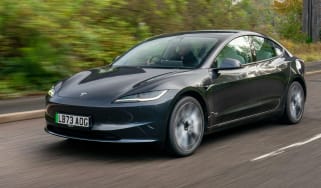
Tesla Model 3 review

New Smart #5 mid-size electric SUV revealed to take on the Skoda Enyaq
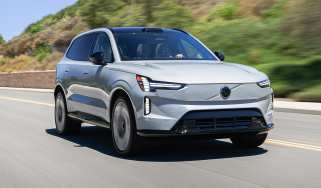
Volvo EX90 review

IMAGES
COMMENTS
Congestion Charge. The Congestion Charge is a £15 daily charge if you drive within the Congestion Charge zone 7:00-18:00 Monday-Friday and 12:00-18:00 Sat-Sun and bank holidays. No charge between Christmas Day and New Year's Day bank holiday (inclusive). The easiest way to pay is by setting up Auto Pay. Exemptions and discounts are also available.
London road user charging. You may need to pay the Congestion Charge, Ultra Low Emission Zone (ULEZ) and/or the Low Emission Zone charges to drive in London. Your number plate (Vehicle Registration Mark) will tell us which charges you need to pay. Discounts or exemptions won't be applied to your vehicle unless you sign in to your account.
Congestion Charge in London
Congestion Charge Zone Map - ULEZ
London Congestion Charge | Price, Times and How to Pay
The London Congestion Charge is a daily fee levied on vehicles travelling through the centre of the capital. In June 2020, its cost was increased to £15 a day (up from £11.50) and the hours of ...
You can pay in advance, on the day of travel or by midnight of the third day after travel. You need to pay a daily charge if you drive within the Congestion Charge zone 07:00-18:00 Mon-Fri, 12:00-18:00 Sat-Sun and bank holidays. No charge between Christmas Day and New Year's Day bank holiday (inclusive). The daily charge is £15 if you pay in ...
London Congestion Charge: a simple guide
London congestion charge
Congestion Charge. The Congestion Charge is a £15 daily charge if you drive within the Congestion Charge zone 7:00-18:00 Monday-Friday and 12:00-18:00 Sat-Sun and bank holidays. No charge between Christmas Day and New Year's Day bank holiday (inclusive). The easiest way to pay is by setting up Auto Pay. Exemptions and discounts are also available.
A 30% increase in the daily congestion charge for driving into central London will be made permanent under Transport for London (TfL) plans. TfL had said the rise - from £11.50 to £15 a day ...
Congestion Charge payments
Avoiding the London Congestion Zone: How to Plan your ...
The Congestion Charge is currently £15 a day if you pay in advance or on the day of travel. If you pay the fee 1 to 3 days after you drive in the zone, you'll be charged an increased amount of 17.50. We provide 24/7 roadside assistance. Buy breakdown cover.
Transport for London (TfL) announced that from 25 December 2025, drivers who previously paid £10 for a year's exemption from congestion charges will have to pay the standard £15 daily fee.
London's congestion charge succeeded for two key reasons: it had a clear and convincing premise, and it was just one part of larger efforts to improve travel across all forms of transport in the ...
Charging times. Congestion Charge (CC): 07:00-18:00 Monday-Friday, 12:00-18:00 Saturday-Sunday and bank holidays. No charge between Christmas Day and New Year's Day bank holiday (inclusive) ULEZ: Operates 24 hours a day, every day of the year, except Christmas Day (25 December) LEZ: Operates 24 hours a day, every day of the year.
Charging times. Congestion Charge (CC): 07:00-18:00 Monday-Friday, 12:00-18:00 Saturday-Sunday and bank holidays. No charge between Christmas Day and New Year's Day bank holiday (inclusive) ULEZ: Operates 24 hours a day, every day of the year, except Christmas Day (25 December) LEZ: Operates 24 hours a day, every day of the year.
Congestion Charge Checker - London Congestion Zone
That means you can drive in and out of the Congestion Charge Zone (CCZ) many times on the same day without facing further penalties. You pay the charge online, on Transport for London's website. You can also pay the charge in advance, or wait until the next day to pay. However, doing the latter adds £3.50 to the total, bringing it to £18.50.
Benefits of Auto Pay. Never forget to pay charges again. Protection from receiving Penalty Charge Notices while registered. Registration for up to five vehicles. You must: Be at least 18 years old. Either complete a Direct Debit mandate or link a payment card. Tell us which vehicles you want to register. See the Auto Pay terms and conditions.
Discounts and exemptions